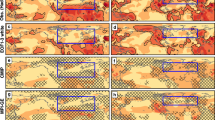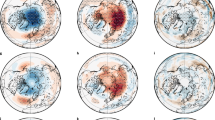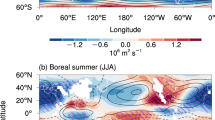Abstract
The temperature of air at the Earth's surface has risen during the past century1, but the fraction of the warming that can be attributed to anthropogenic greenhouse gases remains controversial. The strongest warming trends have been over Northern Hemisphere land masses during winter, and are closely related to changes in atmospheric circulation. These circulation changes are manifested by a gradual reduction in high-latitude sea-level pressure, and an increase in mid-latitude sea-level pressure associated with one phase of the Arctic Oscillation (a hemisphere-scale version of the North Atlantic Oscillation)2. Here we use several different climate-model versions to demonstrate that the observed sea-level-pressure trends, including their magnitude, can be simulated by realistic increases in greenhouse-gas concentrations. Thus, although the warming appears through a naturally occurring mode of atmospheric variability, it may be anthropogenically induced and may continue to rise. The Arctic Oscillation trend is captured only in climate models that include a realistic representation of the stratosphere, while changes in ozone concentrations are not necessary to simulate the observed climate trends. The proper representation of stratospheric dynamics appears to be important to the attribution of climate change, at least on a broad regional scale.
This is a preview of subscription content, access via your institution
Access options
Subscribe to this journal
Receive 51 print issues and online access
$199.00 per year
only $3.90 per issue
Buy this article
- Purchase on Springer Link
- Instant access to full article PDF
Prices may be subject to local taxes which are calculated during checkout



Similar content being viewed by others
References
Hansen, J., Ruedy, R., Sato, M. & Reynolds, R. Global surface air temperature in 1995: Return to pre-Pinatubo level. Geophys. Res. Lett. 23, 1665–1668 (1996).
Thompson, D. W. J., Wallace, J. M. The Arctic Oscillation signature in the wintertime geopotential height and temperature fields. Geophys. Res. Lett. 25, 1297–1300 (1998).
Oort, A. H. & Liu, H.-Z. Upper-air temperature trends over the globe. J. Clim. 6, 292–307 (1993).
Spencer, R. W. & Christy, J. R. Precision lower stratospheric temperature monitoring with the MSU: Technique, validation, and results 1979–1991. J. Clim. 6, 1194–1204 (1993).
Pawson, S., Labitzke, K. & Leder, S. Stepwise changes in stratospheric temperature. Geophys. Res. Lett. 25, 2157–2160 (1998).
Kodera, K. & Koide, H. Spatial and seasonal characteristics of recent decadal trends in the Northern Hemisphere troposphere and stratosphere. J. Geophys. Res. 102, 19433–19447 (1997).
Zurek, R. W., Manney, G. L., Miller, A. J., Gelman, M. E. & Nagatani, R. M. Interannual variability of the north polar vortex in the lower stratosphere during the UARS mission. Geophys. Res. Lett. 23, 289–292 (1996).
Baldwin, M. P., Cheng, X. & Dunkerton, T. J. Observed correlations between winter mean tropospheric and stratospheric circulation anomalies. Geophys. Res. Lett. 21, 1141–1144 (1994).
Perlwitz, J. & Graf, H.-F. The statistical connection between tropospheric and stratospheric circulation of the Northern Hemisphere in winter. J. Clim. 8, 2281–2295 (1995).
Kodera, K., Chiba, M., Koide, H., Kotoh, A. & Nikaidou, Y. Interannual variability of the winter stratosphere and troposphere in the Northern Hemisphere. J. Meteorol. Soc. Jpn 74, 365–382 (1996).
Kitoh, A. Koide, H., Kodera, K., Yukimoto, S. & Noda, A. Interannual variability in the stratosphere-troposphere circulation in a coupled ocean-atmosphere GCM. Geophys. Res. Lett. 23, 543–546 (1996).
Rind, D., Shindell, D., Lonergan, P. & Balachandran, N. K. Climate change and the middle atmosphere. Part III: The doubled CO2climate revisited. J. Clim. 11, 876–894 (1998).
Palmer, T. N. Anonlinear dynamical perspective on climate change. Weather 48, 314–326 (1993).
Hurrell, J. W. Influence of variations in extratropical wintertime teleconnections on Northern Hemisphere temperature. Geophys. Res. Lett. 23, 665–668 (1996).
Hansen, J.et al. Efficient three-dimensional global models for climate studies: Models I and II. Mon. Weath. Rev. 111, 609–662 (1983).
Rind, D., Suozzo, R., Balachandran, N. K., Lacis, A. & Russell, G. The GISS global climate/middle atmosphere model. Part I: Model structure and climatology. J. Atmos. Sci. 45, 329–370 (1988).
Russell, G. L., Miller, J. R. & Rind, D. Acoupled atmosphere-ocean model for transient climate change. Atmosphere-Ocean 33, 683–730 (1995).
Bretherton, C. S., Smith, C. & Wallace, J. M. An intercomparison of methods for finding coupled patterns in climate data. J. Clim. 5, 541–560 (1992).
Wallace, J. M. & Gutzler, D. S. Teleconnections in the geopotential height field during the Northern Hemisphere winter. Mon. Weath. Rev. 109, 784–812 (1981).
Graf, H.-F., Kirchner, I. & Perlwitz, J. Changing lower stratospheric circulation: The role of ozone and greenhouse gases. J. Geophys. Res. 103, 11251–11261 (1998).
Volodin, E. M. & Galin, V. Interpretation of winter warming at Northern Hemisphere continents 1977–94. J. Clim.(in the press).
Shindell, D. T., Rind, D. & Lonergan, P. Increased polar stratospheric ozone losses and delayed eventual recovery due to increasing greenhouse gas concentrations. Nature 392, 589–592 (1998).
Wallace, J. M., Zhang, Y. & Bajuk, L. Interpretation of interdecadal trends in Northern Hemisphere surface air temperature. J. Clim. 9, 249–259 (1996).
Broccoli, A. J., Lau, N. C. & Nath, M. J. The cold ocean warm land pattern: Model simulation and relevance to climate change detection. J. Clim. 11, 2743–2763 (1998).
Boville, B. A. & Cheng, X. Upper boundary effects in a general circulation model. J. Atmos. Sci. 45, 2591–2606 (1988).
Austin, J., Butchart, N. & Swinbank, R. S. Sensitivity of ozone and temperature to vertical resolution in a GCM with coupled stratospheric chemistry. Q.J.R. Meteorol. Soc. 123, 1405–1431 (1997).
Shindell, D. T., Rind, D., Balachandran, N., Lean, J. & Lonergan, P. Solar cycle variability, ozone, and climate. Science 284, 305–308 (1999).
Kodera, K. On the origin and nature of interannual variability of the winter stratospheric circulation in the Northern Hemisphere. J. Geophys. Res. 100, 14077–14087 (1995).
Gong, D. & Wang, S. Definition of Antarctic oscillation index. Geophys. Res. Lett. 26, 459–462 (1999).
North, G. R., Bell, T. L., Cahalan, R. F. & Moeng, F. J. Sampling errors in the estimation of empirical orthogonal functions. Mon. Weath. Rev. 110, 699–706 (1982).
Rosenzweig, C.et al. Building Linkages among Climate, Impacts, and Economics: A Multi-dimensional Approach to Integrated Assessment(Columbia Earth Institute & NASA GISS, New York, NY, (1998).
Corti, S., Molteni, F. & Palmer, T. N. Signature of recent climate change in frequencies of natural atmospheric circulation regimes. Nature 398, 799–802 (1999).
Acknowledgements
We thank J. Hansen, D. Rind and G. Russell for making available their numerical experiments, D. Thompson for providing analyses of the observations and P. Lonergan for assistance with model output. We also thank P. Stone and J. M. Wallace for their comments on earlier drafts of this Letter. G.A.S. was supported by a NOAA postdoctoral fellowship in Climate and Global Change administered by the UCAR Visiting Scientist Program. R.L.M. is supported by the NOAA Atlantic Climate Change Program. Stratospheric modeling at GISS is supported by the NASA Atmospheric Chemistry Modeling and Analysis Program.
Author information
Authors and Affiliations
Corresponding author
Rights and permissions
About this article
Cite this article
Shindell, D., Miller, R., Schmidt, G. et al. Simulation of recent northern winter climate trends by greenhouse-gas forcing. Nature 399, 452–455 (1999). https://doi.org/10.1038/20905
Received:
Accepted:
Issue Date:
DOI: https://doi.org/10.1038/20905
This article is cited by
-
Recent Advances in Understanding Multi-scale Climate Variability of the Asian Monsoon
Advances in Atmospheric Sciences (2023)
-
Indian Ocean warming as key driver of long-term positive trend of Arctic Oscillation
npj Climate and Atmospheric Science (2022)
-
Coupled stratosphere-troposphere-Atlantic multidecadal oscillation and its importance for near-future climate projection
npj Climate and Atmospheric Science (2022)
-
Quantifying the rarity of extreme multi-decadal trends: how unusual was the late twentieth century trend in the North Atlantic Oscillation?
Climate Dynamics (2022)
-
Poleward and weakened westerlies during Pliocene warmth
Nature (2021)
Comments
By submitting a comment you agree to abide by our Terms and Community Guidelines. If you find something abusive or that does not comply with our terms or guidelines please flag it as inappropriate.



